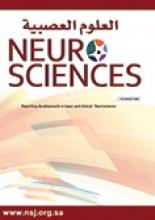Research ArticleOriginal Article
Open Access
Prevalence of depressive symptoms and its correlates in primary headache patients with a history of head-neck trauma
Khalid W. Al Quliti
Neurosciences Journal July 2022, 27 (3) 181-186; DOI: https://doi.org/10.17712/nsj.2022.3.20220037
Khalid W. Al Quliti
From the Department of Medicine, College of Medicine, Taibah University, Al Madinah Al Munawarah, Kingdom of Saudi Arabia.
MBBS, MD
References
- 1.↵American Psychiatric Association.Diagnostic and Statistical Manual of Mental Disorders: DSM-5. 5th Edition. 2013. American Psychiatric Association. Washington (DC); American psychiatric association; 2013. p. 156–189.
- 2.↵World Health Organization. Depression. [Updated 2021; Accessed date?]. Availble from: https://www.who.int/news-room/fact-sheets/detail/depression
- 3.↵
- Amiri S,
- Behnezhad S,
- Azad E.
- 4.↵
- 5.↵
- Kamins J,
- Charles A.
- 6.↵
- Lipton RB,
- Fanning KM,
- Buse DC,
- Martin VT,
- Hohaia LB,
- Adams AM, et al.
- 7.↵
- Buse DC,
- Greisman JD,
- Baigi K,
- Lipton RB.
- 8.↵
- Lovibond SH,
- Lovibond PF.
- 9.↵
- Henry JD,
- Crawford JR
- 10.↵
- Ali AM,
- Alkhamees AA,
- Hori H,
- Kim Y,
- Kunugi H. The Depression
- 11.↵
- Manzar MD,
- Hameed UA,
- Salahuddin M,
- Khan MY,
- Nureye D,
- Wakene W, et al.
- 12.↵
- Hayes AF,
- Coutts JJ.
- 13.↵
- Ishii R,
- Schwedt TJ,
- Trivedi M,
- Dumkrieger G,
- Cortez MM,
- Brennan KC, et al.
- 14.↵
- Shaw L,
- Morozova M,
- Abu-Arafeh I.
- 15.↵
- 16.↵
- Amin FM,
- Aristeidou S,
- Baraldi C,
- Czapinska-Ciepiela EK,
- Ariadni DD,
- Di Lenola D, et al.
- 17.↵
- Chattu VK,
- Manzar MD,
- Kumary S,
- Burman D,
- Spence DW,
- Pandi-Perumal SR
- 18.↵
- Ashina H,
- Iljazi A,
- Al-Khazali HM,
- Ashina S,
- Jensen RH,
- Amin FM, et al.
In this issue
Prevalence of depressive symptoms and its correlates in primary headache patients with a history of head-neck trauma
Khalid W. Al Quliti
Neurosciences Journal Jul 2022, 27 (3) 181-186; DOI: 10.17712/nsj.2022.3.20220037
Jump to section
Related Articles
- No related articles found.





